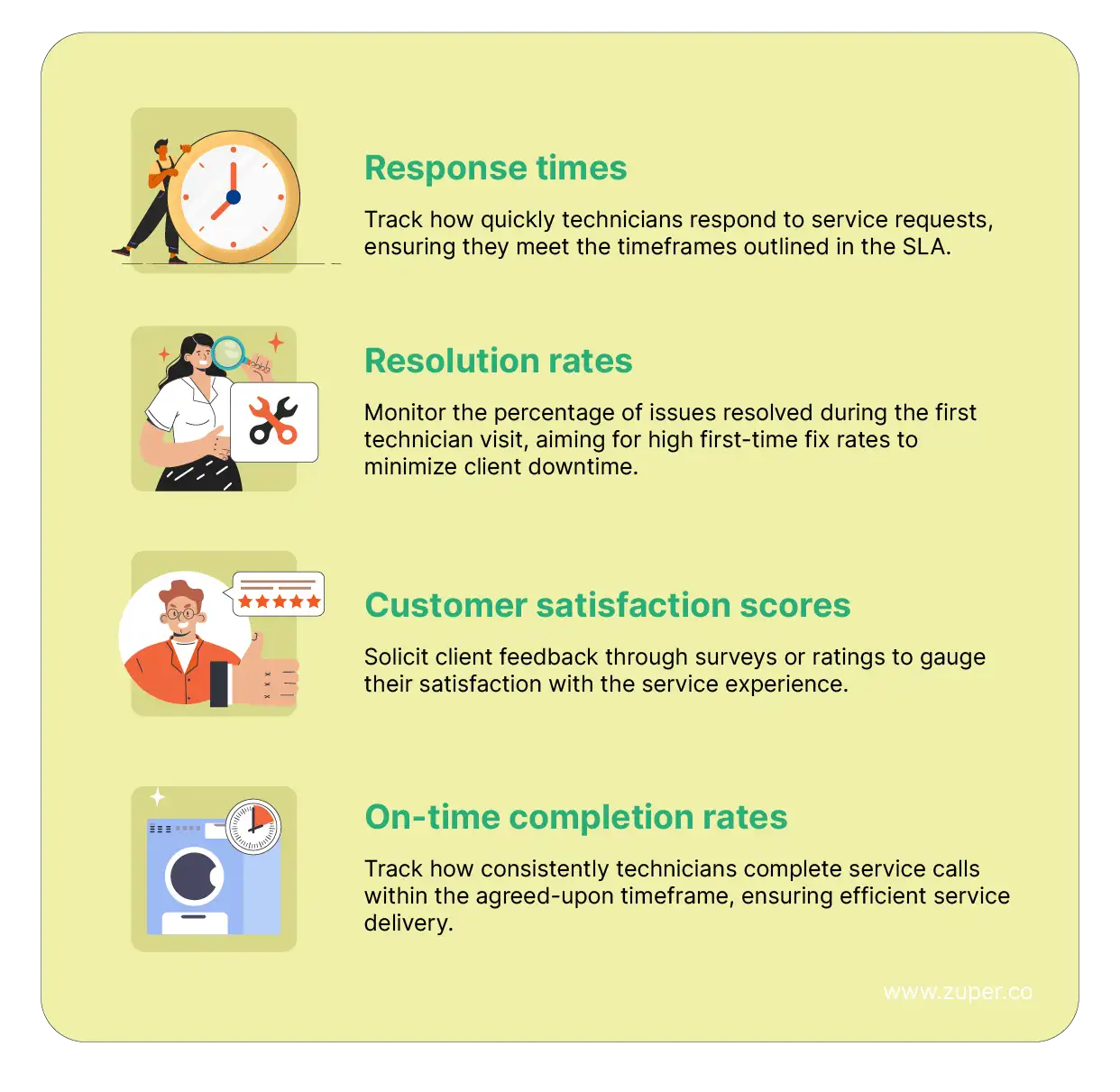The field service industry thrives on a simple yet crucial principle: keeping clients’ operations running smoothly. Reliable service delivery creates a dynamic environment where trust and efficiency reign supreme. Field service providers are constantly looking for innovative strategies to exceed client expectations. A Service Level Agreement (SLA) is a powerful tool that helps with legal documentation by using software to assist the legal industry and provide services. The global legal tech market was valued at 28 billion US dollars, which is set to increase further in the coming years. The field service industry is also undergoing a period of rapid transformation. Client expectations are shifting, with a growing emphasis on prompt response times, transparent communication, and proactive maintenance strategies. Technology is also playing a transformative role, with advancements in data analytics, mobile apps, and the Internet of Things (IoT) all impacting how services are delivered and managed. With these dynamic changes, trust and efficiency are critical differentiators to help field service businesses stand out. Streamlined operations are essential to maximize technician productivity and minimize downtime for clients.
While SLAs serve as formal agreements, their value lies in their ability to foster a collaborative partnership between service provider and client. Both parties are invested in achieving a successful outcome by working together to define service levels, communication channels, and performance metrics. This collaborative approach strengthens trust and lays the foundation for long-term success. Effective SLAs are not simply contracts; they are strategic tools that empower field service providers to deliver consistent service.
SLAs provide a framework for achieving trust and efficiency by establishing clear expectations, communication protocols, and performance benchmarks. When crafted effectively, SLAs foster collaboration, streamline processes and ensure consistent service delivery. This article will explore some of the best practices used to craft customized agreements, leverage technology for enhanced efficiency, and foster continuous improvement. By harnessing the power of SLAs, field service providers can transform client interactions, build enduring partnerships, and achieve sustainable business growth. *source.

The power of effective service level agreements
The power of a well-crafted Service Level Agreement (SLA) should not be underestimated! This formal document between a field service provider and a client goes far beyond a legal formality. It’s a strategic tool that fosters trust, streamlines operations, and, ultimately, keeps customers happy. A study by the Northridge Group finds that an alarming 73% of consumers report they are likely to switch to a competitive brand after just one negative experience. SLAs help mitigate any negative experiences caused by delays and establish clear expectations for response times, service parameters, and communication protocols. This transparency builds trust and ensures clients’ needs are met efficiently, often exceeding expectations.
Clarity breeds efficiency, and SLAs help define specific service parameters and response timeframes. This allows field service providers to optimize scheduling and resource allocation. Technicians can be dispatched with the right skills and tools for the job, minimizing wasted time and maximizing productivity. Unforeseen circumstances are an inevitable part of any industry, and SLAs mitigate these risks by clearly outlining communication protocols and escalation procedures. Both parties understand their roles and responsibilities in case of unexpected issues. This transparent communication reduces misunderstandings and potential disputes, ensuring a smooth resolution. Effective SLAs are a win-win partnership for field service providers and their clients. They pave the way for exceptional service delivery, efficient operations, and a prosperous and long-lasting business relationship.
Crafting customized service agreements tailored to your advantage
In today’s dynamic field service landscape, success hinges on customization, and a one-size-fits-all service agreement will not cut it. Effective SLAs are not simply legal documents but strategic partnerships forged between field service providers and clients. Tailoring agreements are a win-win for both parties in addressing specific needs, fostering trust, optimizing operations, and delivering exceptional service. Let’s look at how to craft winning SLAs to gain a competitive edge.
1. Data is the fuel for realistic expectations
Data is fuel for successful field service operations. Don’t underestimate the power of historical data in crafting realistic and achievable service level expectations within your SLAs. By analyzing past service requests, you can gain valuable insights into the following:
- Identify the types of repairs most commonly requested by similar clients. This allows you to tailor service offerings within the SLA, ensuring you’re prepared to address their most pressing needs.
- Historical response time data paints a clear picture of your current performance. Utilize this information to establish achievable benchmarks within the SLA. Avoid overpromising and underdelivering; set realistic expectations to build client trust.
- Service history combined with equipment specifications can be a powerful asset. Analyze this data to predict potential maintenance requirements for specific equipment types your clients use. This allows you to propose proactive maintenance strategies within the SLA, minimizing downtime and maximizing operational efficiency for your clients.
2. Communication is the cornerstone of trust
Open and honest communication is paramount in any successful partnership, and field service agreements are no exception. SLAs should clearly define communication protocols to ensure everyone is on the same page; this includes:
- Clearly defining who clients should contact for service requests, how escalation procedures will work, and the frequency of progress updates. Transparent communication fosters trust and ensures clients feel informed throughout the service lifecycle.
- Outline how service performance will be measured and reported to the client. This could involve metrics like response times, resolution rates, and customer satisfaction scores. Establishing clear performance benchmarks and sharing results demonstrates accountability and commitment to quality service.
3. Use technology to streamline process efficiency
Technology plays a pivotal role in streamlining service delivery and upholding SLA commitments. By outlining responsibilities and expectations, SLAs can facilitate smoother customer interactions. Consider integrating the following solutions to enhance efficiency and elevate your service offerings.
- Automated dispatching based on technician location and expertise is a game-changer. Scheduling apps leverage this data to optimize response times, ensuring clients receive timely service.
- Seamless communication between technicians, dispatchers, and clients is essential. Real-time communication platforms facilitate instant updates, ensuring everyone involved is aware of progress and potential delays. This keeps clients informed and fosters a sense of collaboration.
- With robust field service management software, you can streamline workflow management, track inventory levels, and access service history data. This empowers technicians with the information they need to deliver efficient and informed service and uphold the promises made within the SLA.
4. Adapting to change and cultivating long-term partnerships
Effective SLAs are not static documents but living agreements that can evolve as your customers’ needs change. As a customer’s business grows or shrinks over time, different levels of service will be required. Setting up an effective SLA this year may need to be revised next year as clients adopt new technologies or business processes.
- Review and update your SLAs regularly to reflect these changes. This collaborative approach demonstrates your commitment to continuous improvement and fosters long-term client partnerships.
- You position your company as a reliable and valued partner by fostering trust and demonstrating responsiveness to their evolving needs.
By embracing these key principles, leveraging data, prioritizing communication, utilizing technology, and cultivating long-term partnerships, you can craft customized SLAs that position your field service business for success. Remember, effective SLAs are not just about fulfilling service requests; they are about building trust, ensuring efficiency, and delivering exceptional service that keeps your clients coming back.
Emerging trends and the future of service level agreements
Service-level agreements are experiencing a wave of innovation. Gone are the days of solely focusing on response times. Emerging trends include outcome-based SLAs, incentivizing successful service outcomes with penalties for missed targets. Integrating AI and machine learning promises dynamic SLAs that adapt to real-time data, and self-service portals empower clients while reducing the burden on service providers. The future of SLAs is all about collaboration, efficiency, and achieving win-win partnerships.
Outcome-based SLAs
The traditional focus on response times within SLAs is evolving. A growing trend is the rise of outcome-based SLAs; these agreements emphasize achieving successful service results. Imagine an SLA guaranteeing a specific reduction in client equipment downtime or a fixed penalty for missing agreed-upon performance metrics. This shift fosters a shared interest in achieving positive results. The service provider and the client are invested in successful outcomes, driving a collaborative approach to service delivery.
Integration of AI and machine learning for predictive service
The latest technology drives the future of SLAs, and advancements in AI and machine learning pave the way for dynamic SLAs that adapt to real-time data. Imagine having an SLA template that analyzes equipment health sensors and service history to predict potential issues. This allows for proactive maintenance strategies, addressing problems before they escalate into significant breakdowns. By utilizing AI and machine learning, service providers can create dynamic SLAs that minimize downtime, enhance operational efficiency, and ultimately lead to a substantial boost in customer satisfaction.
Empowering clients with self-service portals to streamline operations
The future of service delivery is all about empowering clients; a rising trend is the integration of SLAs with self-service portals. These online platforms offer clients a range of functionalities, including the ability to submit service requests. Your clients can conveniently report issues and initiate service requests through the portal. Track progress in real-time without the need to wait for updates. Self-service portals allow clients to monitor the progress of their service requests, fostering transparency and peace of mind. They can also access historical data, and some portals even offer optional appointment scheduling features, allowing clients to choose a convenient time window for technician visits. This flexibility further enhances the customer experience.
Best practices to implement effective SLAs
Crafting a winning SLA goes beyond outlining service levels; it comes down to translating those promises into tangible results. This section explores key best practices to implement effective SLAs, focusing on clear communication, measurable performance metrics, and a commitment to continuous improvement. By following these strategies, you can transform your SLAs from legal documents into powerful tools that build trust, foster collaboration, and drive exceptional service delivery.
Clearly define service level agreements to avoid confusion
A strong foundation is essential for any successful partnership, and well-defined service levels are the cornerstone of an effective SLA. Don’t leave room for misinterpretation; clearly outline the specific services in the agreement, ensuring both parties are on the same page. Define response timeframes for service requests, setting expectations for how quickly clients can expect a technician to arrive. Resolution targets, like first-time fix rates, should be clearly established to ensure efficient service delivery. Finally, include service quality metrics, such as adherence to safety protocols, to demonstrate your commitment to a high standard of service. Clearly defining these elements creates transparency, fosters trust, and sets the stage for exceptional service delivery.
Tracking success with measurable KPIs for continuous improvement
SLAs are not static documents; they are tools for continuous improvement. To measure adherence to the agreement and identify areas for enhancement, establish clear Key Performance Indicators (KPIs). These quantifiable metrics provide valuable insights into service delivery effectiveness; a few examples include:

By monitoring these KPIs and analyzing the data, you can identify areas for improvement, refine your service processes, and continuously strive to exceed client expectations.
Building partnerships, not just agreements
Collaboration is at the heart of successful SLAs. Move beyond a one-sided approach and work with clients to establish mutually agreeable service levels and performance metrics. Consider their specific needs and priorities. Offering tiered service packages can be a winning solution. These packages can feature different response times and service guarantees at varying price points, allowing clients to choose the option that best aligns with their budget and the criticality of the service. This collaborative approach fosters trust and positions your company as a reliable partner invested in their success.
Building trust through realistic expectations
Transparency is paramount when establishing trust with clients. Don’t fall into the trap of overpromising and underdelivering. Instead, set realistic service level expectations within your SLAs. Utilize historical data on response times, resolution rates, and your team’s capabilities to set achievable benchmarks. By prioritizing realistic targets, you build trust and demonstrate a commitment to consistently delivering high-quality service your team can meet. This approach fosters a collaborative partnership where both parties work together to achieve success.
Equipping your team for success by investing in technician training
Your technicians are the backbone of exceptional service delivery. Invest in ongoing training programs to ensure they can uphold the promises made within the SLA. This empowers them with the knowledge and skills needed to excel. Training should encompass the following.
Relevant service procedures – Ensure technicians are proficient in servicing the specific equipment the SLA covers. Provide regular updates on new technologies and troubleshooting techniques.
Communication skills – Effective communication is critical. Train technicians to communicate clearly and concisely with clients, keeping them informed throughout the service process.
Best practices for adhering to established timeframes – Timeliness is crucial, as well as training technicians on efficient service procedures and effective time management strategies. This will allow them to meet the response and resolution targets outlined in the SLA.
Investing in technician training empowers your team to deliver exceptional service consistently, upholding the commitments made within the SLA and fostering trust with your clients.
Building trust through transparency, communication, and proactive service
Open communication is the cornerstone of a strong client relationship. Throughout the service lifecycle, keep clients informed via clear communication channels. Provide timely updates on service progress, ensuring they understand the status of their request. Don’t shy away from potential delays; address them promptly and transparently, outlining the reason for the delay and the revised timeline. Propose clear resolution strategies, demonstrating a commitment to finding solutions.
Shift your focus from reactive repairs to proactive service by embracing a preventive maintenance culture. Analyze historical data to identify potential equipment issues before they escalate into significant breakdowns. Schedule proactive maintenance visits based on this data, minimizing client downtime and maximizing equipment lifespan. By prioritizing communication and proactive service, you foster trust, demonstrate a genuine interest in client success, and set your company apart as a reliable service partner.
Optimizing service delivery technology for continuous improvement
Technology helps you optimally uphold SLA commitments. Implement tools like scheduling apps to optimize technician dispatching based on location and expertise, ensuring prompt service. Real-time communication platforms keep everyone informed, fostering collaboration. Field service management software helps you streamline workflows, track inventory, and provide technicians with crucial service history data. These technologies enhance efficiency and empower technicians to deliver exceptional service.
SLAs are not set in stone; hence, embracing a continuous improvement process is essential. Regularly review agreements to reflect changing client needs, evolving technologies, and insights from performance data. Hold periodic meetings with clients to discuss their satisfaction and identify areas for improvement. By fostering a collaborative approach and leveraging technology, you can continuously refine your service delivery and solidify your position as a trusted service partner.
Adapting to the future of SLAs
The field service industry is poised for a period of remarkable transformation. Emerging technologies and evolving customer expectations are reshaping the Service Level Agreements (SLAs) landscape. To thrive in this dynamic environment, service providers must embrace innovation and craft SLAs that are not just legal documents but strategic tools for building trust and exceeding client expectations. Several key trends will define the future of SLAs, with clients increasingly seeking self-service options. SLAs integrated with self-service portals empower clients to submit service requests, track progress, access historical service data, and even schedule appointments. This reduces the burden on service providers and enhances the client experience by offering 24/7 access to service information. The Internet of Things (IoT) will play a pivotal role in creating SLAs in the future. Sensors embedded in equipment will provide real-time data on equipment health, enabling a paradigm shift from reactive repairs to proactive maintenance. SLAs can be tailored to address potential issues before they escalate, minimizing downtime and enhancing overall client reliability.
The future of SLAs is cantered on customer experience. Metrics that go beyond response times and resolution rates will take center stage. Client satisfaction scores and Net Promoter Scores (NPS) will become crucial benchmarks for evaluating SLA performance. By prioritizing customer experience throughout the service lifecycle, service providers can cultivate long-term partnerships and achieve sustainable business growth. By embracing these trends and fostering a culture of continuous improvement, service providers can craft dynamic, data-driven, and client-centric SLAs. In this transformative era, effective SLAs will be the cornerstone for building trust, delivering exceptional service, and securing a competitive edge in the ever-evolving field service industry.
Ready to harness the power of SLAs to elevate your field service operations? Visit our website to learn how to craft winning service-level agreements. You can even schedule a personalized demo with us, and we can show you how simple it is to create customer-friendly service-level agreements with Zuper.



